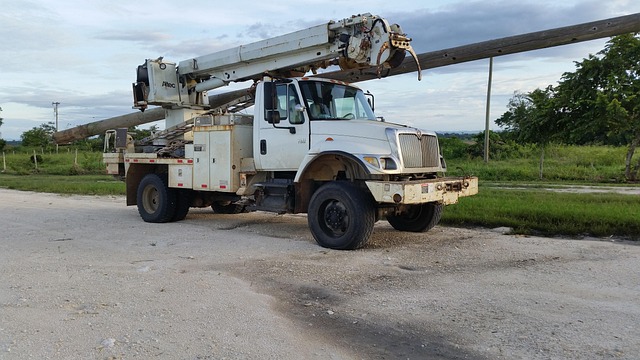Looking to register your car in California? This comprehensive guide walks you through every step, from understanding the requirements to receiving your license plate. Registering your vehicle is a crucial process that involves gathering specific documents and completing essential procedures, such as DMV VIN verification. By following these straightforward steps, you’ll ensure a smooth registration experience in the Golden State.
- Understand Requirements for Car Registration in California
- Gather Necessary Documents for Vehicle Registration
- Perform DMV VIN Verification Step-by-Step
- Submit Application and Pay Fees for Car Registration
- Receive Your Registered Vehicle's License Plate
Understand Requirements for Car Registration in California

Before you can register your car in California, it’s crucial to understand the requirements and processes involved. The first step is ensuring that your vehicle meets all safety standards and emissions regulations set by the state. This includes a comprehensive inspection that covers critical components like brakes, lights, and emissions systems.
Additionally, the California Department of Motor Vehicles (DMV) requires a Vehicle Identification Number (VIN) verification, which can be efficiently conducted using a mobile vin verifier or through a vin inspection. The DMV will cross-reference your vehicle’s information against their records to ensure it’s not stolen, has no outstanding liens, and complies with all legal requirements for registration. This process, along with providing necessary documents like proof of insurance and ownership, will enable you to obtain the required registration plates and legally operate your vehicle on California roads.
Gather Necessary Documents for Vehicle Registration

Before you start the registration process, make sure you have all the required documents ready. The California Department of Motor Vehicles (DMV) will need a range of information to verify your vehicle’s ownership and identify you as the new registered owner. This includes providing proof of identification, such as a valid driver’s license or state ID card. Additionally, you’ll require the vehicle’s title, which can be obtained from the previous owner or through an online title transfer service. The Vehicle Identification Number (VIN) is another critical piece of information that acts as a unique fingerprint for your car. You can easily verify it with a mobile vin verifier or conduct a vin inspection yourself to ensure its accuracy.
Don’t forget to bring proof of insurance, as this is mandatory when registering your vehicle in California. Some documents, like registration papers from another state, might also be needed to facilitate the transfer process. With all these prepared, you’ll be one step closer to completing your car’s mobile vin verification and registration at the DMV.
Perform DMV VIN Verification Step-by-Step

Performing a DMV VIN (Vehicle Identification Number) verification is a crucial step when registering your car in California. This process ensures that the vehicle matches its listed details, providing a layer of protection against fraud and ensuring the safety and legality of your vehicle. Here’s how to navigate this step efficiently:
1. Collect Necessary Documents: Before heading to the DMV, prepare all required documents, including the title, registration papers, and proof of insurance. Additionally, you’ll need to have your vehicle’s VIN readily available, either on the dashboard or in your owner’s manual.
2. Access the DMV Website: Start by visiting the California DMV website. Look for a section dedicated to vehicle registration, where you should find an option for VIN verification. Some counties might offer online tools to check your VIN independently before visiting a field office.
3. Enter Your VIN: On the designated form or website, input your vehicle’s unique 17-character VIN. Ensure accuracy during this step as any errors may lead to delays.
4. Follow Verification Instructions: The DMV will guide you through the process, which might include confirming certain details about your car, such as its make, model, and year. Some counties may even offer a mobile vin inspection or verification service for added convenience. If all information checks out, the next step is to complete the registration process at a local DMV field office.
Submit Application and Pay Fees for Car Registration

After gathering all the necessary documents and ensuring your car meets California’s requirements, it’s time to submit your application for car registration. You can do this through the California Department of Motor Vehicles (DMV) online or in-person at a local DMV office. If you choose to go in-person, prepare to wait as DMV offices can be busy. The process involves filling out an application form and providing proof of insurance, ownership, and identity.
Once your application is complete, you’ll need to pay the associated fees for car registration. These fees vary based on vehicle type and age, so check the DMV website or consult a representative for current rates. As part of the registration process, a DMV vin verification will be conducted to ensure the Vehicle Identification Number (VIN) matches the vehicle you have presented. You can complete this step easily by using a mobile VIN verifier, which allows for a quick and convenient vin inspection right from your smartphone.
Receive Your Registered Vehicle's License Plate

After completing your vehicle’s registration and ensuring all necessary documents are in order, it’s time to receive your new license plates. The California Department of Motor Vehicles (DMV) will issue a set of plates that display your unique Vehicle Identification Number (VIN). These plates are not only decorative but serve as a crucial identifier for your vehicle during mobile VIN verification or inspection.
You can expect a swift process, especially if you’ve opted for a mobile VIN inspection, allowing you to verify your car’s registration and receive its license plates without the hassle of visiting a DMV office. This efficient system is designed to save you time and ensure that your vehicle’s details are accurately recorded and reflected on your license plate.
Registering a car in California involves understanding key requirements, gathering essential documents, completing a straightforward DMV VIN verification process, submitting an application with relevant fees, and ultimately receiving your vehicle’s license plate. This step-by-step guide ensures you navigate the process efficiently, making it a smooth experience for new or existing California drivers alike. Remember, proper registration is crucial for road safety and legal compliance.
